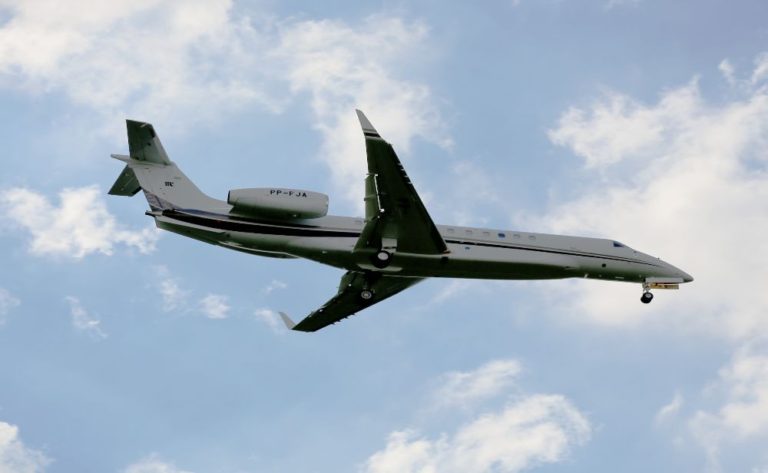Gulfstream 280 Guide and Specs: All You Need To Know [2022]

Introduction
Gulfstream Aerospace, an American firm, commissioned Israel Aerospace Industries (IAI) to design a twin-engine, medium-sized business jet for them to sell under the name Gulfstream G280. The jet, which was first shown in 2008, is a development of their earlier work with the Gulfstream G200. An all-new glass cockpit, upgraded engines, a revised wing, and an anti-icing system are some of the differences that can be found between the Gulfstream G200 and the Gulfstream G280. The Gulfstream G280 is covered by a brand new type certificate, despite the fact that it is a development of the Gulfstream G200. 213 aeroplanes have been handed over to their respective owners since the year 2012.
Gulfstream G280 / Specs
The passenger cabin has a very softly sunken floor and measures 6.3 feet in height, 7.2 feet in width, and 25.8 feet in length. Because of this, even tall passengers will find that standing up in the Gulfstream G280 is a comfortable experience. The aircraft has the capacity to seat up to 12 passengers; however, the cabin is typically configured with six seats arranged in a double club arrangement and a sofa that can accommodate up to three more passengers. The safety standards for the divan’s centre seat do not allow it to be used during takeoffs and landings. On longer flights, passengers can transform their club seats into beds by reclining them all the way back to a berth position. The ten-seaters have a capacity for five people to sleep, compared to the conventional eight-seat configuration’s rating of four people who can sleep.
There is a fully-equipped kitchen located between the cockpit and the passenger cabin. It is equipped with a microwave that can be switched out for a convection oven at the customer’s request, cold storage, a coffee maker, an ice drawer, a sink that has access to both hot and cold water, a countertop that can be extended, and a large amount of room for storing food and cutlery.
A closed lavatory with a vacuum toilet and a 10 cu. ft. cupboard may be found at the aft end of the boat. The inside of the aeroplane, which features no less than 19 huge windows, has been hailed for its lightness and brightness. An interesting feature of the aircraft is that the rear baggage compartment, which can hold up to 1980 pounds and has a volume of 120 cubic feet, is accessible even when the aircraft is in flight. At this time, entry to the compartment is only permitted below FL400; nevertheless, this restriction is considered to be “artificial” and is connected to the process of certification. Gulfstream is currently working together with the FAA and EASA to investigate the possibility of having this limit removed.
Control of the cabin management system (CMS) of the Gulfstream can be exercised either from the flight deck, the passenger cabin, or through the use of an iOS app. This allows for adjustments to be made to the aircraft’s temperature, lighting, and entertainment options. The Gulfstream G280 is one of the most pleasant business jets in its class because to its numerous amenities and its roomy cabin, which complement the aircraft’s impressive range rather nicely.
The propulsion comes from a pair of Honeywell HTF7250G turbofan engines, each of which is capable of providing 7624 lbf of thrust. The HTF7250G are outfitted with thrust reversers and have a dual-channel FADEC in its design. This powerplant from Pratt & Whitney Canada is not only more powerful, but it also uses less gasoline than the Pratt & Whitney Canada PW306A that was installed in the Gulfstream G200. Because of this, IAI and Gulfstream were able to remove the fuel tank from the rear fuselage of the Gulfstream G280. After the tank was removed, the interior of the cabin was able to be stretched by another 17 inches, providing more comfort for the passengers.
The Rockwell Collins PlaneViewG280 suite is the most recent iteration of the renowned Pro Line Fusion product line produced by the business. This suite may be found on the flight deck of the Gulfstream G280. The information is shown to the pilots on three monitors that are each 15 inches in size. Two flight management system (FMS) units are located by the throttles and serve as the means by which data is entered. The Gulfstream G280 was designed with the intention of maintaining its status as a cutting-edge aircraft while still maintaining a sense of continuity with the rest of the Gulfstream family, including the huge planes. Although synthetic vision is technically a feature that can be turned off, because to its widespread popularity among viewers, you may have a difficult time finding a G280 that does not include it.
Gulfstream G280 / Prices
In general terms, the buyer will have to shell out $25 million in order to purchase a brand-new Gulfstream G280 in its standard configuration. Since the first year that the aircraft was available for purchase in 2012, this pricing has not changed.
Performance and Maneuverability of the Gulfstream G280
The airfoil design of the larger Gulfstream G550 was utilised to develop the enhanced wing that is featured on the Gulfstream G280. In comparison, the G200 wing only has a total area of 369 square feet. This wing has a total area of 495 square feet. When combined with the enhancements made to the engines, this enables the Gulfstream G280 to reach FL430 without the use of any stages. The G280 can go from sea level to FL430 in just 20 minutes when loaded to its full takeoff weight capacity. The Gulfstream G200’s cruise speeds increased to Mach 0.80 from the previous Mach 0.75. The Gulfstream G280 has a total fuel burn of 1800 pounds per hour while it is operating at FL410 and Mach 0.82.
The range of the Gulfstream G280 is one of its strongest features. With four passengers with NBAA IFR reserves, the aircraft is capable of travelling 3,600 nautical miles at a speed of 0.80 Mach. This opens up the possibility of nonstop flights connecting major cities such as New York and Los Angeles, as well as Dubai and Singapore.
According to the designers, leading-edge devices, flow gates, flap track boats, and everything else that adds complexity and has trade-offs is not allowed on Gulfstream wings. This is because the designers have an almost allergic reaction to aerodynamic devices. The G280 has spoilers that are activated automatically during landing to rid the aircraft of excess lift. These spoilers are controlled by the fly-by-wire system installed in the aircraft. The flight control system also has control over the rudder of the aircraft.
The performance of the Gulfstream G280 upon landing is usually regarded as being favourable. The aircraft was able to pass the certification tests for the notoriously congested London City Airport, which is located in the middle of the English capital. These tests were accomplished with the help of the aircraft’s autonomous spoilers and autobraking system.
In contrast to the cruciform empennage of the Gulfstream G200, the empennage of the Gulfstream G280 is in the shape of a T. Both aerodynamics and aesthetics had a role in the decision. The elevator authority was increased, and the designers “wanted it to seem more like a Gulfstream.”
Gulfstream G280 / Maintenance Schedule
The engine is the primary component of the Gulfstream G280 that requires regular maintenance attention, as is the case with the vast majority of aircraft. It is equipped with two aft-mounted Honeywell HTF7250G engines, both of which adhere to modern maintenance procedures. These procedures improve dispatch reliability while simultaneously lowering costs for operators over the short and long term.
The HTF7250G, in contrast to the vast majority of its forerunners, does not necessitate any mandatory schedule overhauls or hot section teardown inspections. Honeywell designed them to make use of a programme called “on-condition maintenance,” in which the engine is only taken out of the aircraft in one of three circumstances: if a problem occurs while it is being flown, if a problem is discovered during a scheduled inspection, or if a component reaches the end of its useful life. Due to the reduced number of regularly scheduled events, using the on-condition strategy that was chosen with the HTF7250G makes it more difficult to create a maintenance budget. This is one of the few drawbacks of this technique. Many owners have circumvented this problem by ensuring that their engines are maintained according to the Honeywell MSP programme.
The Aircraft Maintenance Manual, the Maintenance Review Board Report, and the Engine Maintenance Manuals all indicate that the Gulfstream G280 is still expected to participate in a number of significant scheduled events in the near future.
An inspection of the engines is required once every year or every 500 hours, whichever comes first. The same thing takes place every two years or every 1000 hours, at which point an oil change is required. This requirement has been waived in favour of doing an oil filter change in conjunction with an analysis every 150 to 250 hours. At the end of four years or 2000 hours of operation, the turbine stage 1 rotor blades and the aft flow discourager require a comprehensive inspection. Additionally, the starter fuel nozzles and the engine fuel filter must be replaced at this time.
A comprehensive check of the aircraft is required every eight years or every 4,000 to 4,800 flight hours, whichever comes first. As the majority of the access work will be finished by the time the 2,000-hour inspection rolls around, it is strongly suggested that this be performed concurrently with it. At the end of every 7000 hours of operation, the hydro-mechanical unit of the engine needs to be taken apart, cleaned, reassembled, and then put through its paces. Finally, the same treatment must be performed on the compressor zone borescope once every sixteen years or 9600 hours, whichever comes first.
Gulfstream G280 / Upgrades and Changes to Interior and Exterior
Because it is still a relatively new design, the Gulfstream G280 has not yet been subjected to any significant modifications by either IAI or Gulfstream. That does not mean that work of this nature will never be possible. Mark Burns, the Chief Executive Officer of Gulfstream Aerospace, stated at a conference in March 2021 that the company is planning several upgrades with the goals of lowering the amount of work required of the pilots, enhancing the travelling experience for passengers, and increasing the aircraft’s overall level of safety.
There is a vertical weather analysis system, a predictive wind shear system, and a surface management system among these. The surface management system will inform pilots of risky ground operations in order to prevent runway incursions. The aircraft’s existing environmental control system, which maintains a 100% fresh air rating, will be supplemented by a new air purification system, which the passengers will be able to enjoy during their flight. Additionally, the pressurisation is scheduled to be upgraded, and will go from the current 7000 feet in the cabin to FL450.
Where to Obtain Replacement Components for the Gulfstream G280
It is not difficult to obtain parts for the Gulfstream G280. These parts can be procured from shops individually or with the assistance of maintenance programmes for aircraft that have a subscription to one.
Gulfstream G280 / Frequently Encountered Issues
Since it was first flown in 2012, the Gulfstream G280 has had a life that is, on the whole, free of significant complications; but, as is the case with the vast majority of aircraft, there have been a number of service bulletins issued. The most important ones are the maintenance of the tower shaft bearing, the fourth bearing in the turbine core, and the fourth carbon seal. Additionally, on both engines, an upgraded annular ball bearing was installed, and the 4th roller bearing and its associated carbon seal were replaced.
Options for Insurance for the Gulfstream G280
According to the GuardianJet private aviation service, the cost of hull insurance for a Gulfstream G280 is $24371, and the cost of liability insurance on top of that is $35,000. These estimations are based on the assumption that the crew is reasonably experienced, having at least 50 hours on the type, as well as current commercial, multi-engine, and instrument flight ratings, and that they fly an average of 300 hours each year.
Gulfstream G280 / Resale Value
It is anticipated that a secondhand Gulfstream 280 will cost around $16 million to purchase in the year 2021 on average. However, it is conceivable to find aeroplanes on the market selling for anywhere from $13 million to $19 million, and the price will vary depending on the year that the airframe was manufactured, the number of hours and landings, and participation in engine maintenance programmes.
Reviews from Current Gulfstream G280 Pilots
Both owners and pilots of the Gulfstream 280 express a high level of satisfaction with the aircraft. Its performance enables it to compete with more expensive aircraft at a lesser cost, while still delivering in terms of payload and passenger capability. This is made possible by the fact that it can fly faster. When compared to the previous generation that was equipped with Pratt & Whitney engines, the dispatch rates achieved by Honeywell as a result of their efforts to streamline engine maintenance saw a significant improvement. The jet’s safety features, such as the multiple flight control redundancies that still permit the pilot to fly with their head outside the cockpit or the automatic thrust correction applied to the rudder by the fly-by-wire system in the event that a single engine fails to start, are also very much appreciated.
Gulfstream G280 / Similar Aircraft
The Gulfstream G280 faces competition both from other options operating in the same market segment as it does as well as from options operating in “neighbouring” segments that cut into its market share. Along with Gulfstream’s own forerunners, the Citation X+ and Longitude families produced by Cessna, as well as the Legacy and Praetor families produced by Embraer, present a formidable challenge to the sales prospects of Gulfstream’s new jet.
Cessna has just recently stopped production of the Citation X+ in favour of the Citation Longitude in order to avoid having two projects that are in direct competition with one another, despite the fact that they are technically in different classes. When compared to the G280’s range, both of these options are competitive alternatives. The Citation X+ takes the cake when it comes to speed thanks to its claim of being the world’s fastest business jet, while the Longitude is not quite as blistering in performance but makes up for it by bringing down costs.
In recent years, the Legacy and Praetor ranges have absolutely dominated the market for their respective categories. Before, the Brazilian company was known for the regional airliners it manufactured; later, with the launch of the Phenom and Legacy series, it was able to achieve the same level of success. While it initially offered either a very light jet or a converted regional airliner, it quickly filled in the gaps in its lineup by releasing the Legacy 450 and 500, as well as the Praetor 500 and 600 models. The range of the Praetor 600 is significantly greater than that of the Gulfstream product line, coming in at a total of 4018 nautical miles (nmi) in addition to IFR reserves. In most cases, the costs of acquiring the jet and operating it are also lower than those associated with the G280.
You Can Join One Of These Gulfstream G280 Clubs
At this time, there are no specific owner clubs available for Gulfstream aircraft that one can join. This pattern appears to be consistent across the majority of executive aviation types, which is largely attributable to the relatively high ownership costs for private individuals. As a result, the majority of aircraft are owned or managed by businesses rather than by individuals. There are still places on the internet, such as Facebook pages and online forums, where pilots and owners of Gulfstream aircraft, including the G280, can go to get guidance and talk about their cherished aircraft.
FAQ
To purchase a Gulfstream G280, how much do you need to spend?
To answer your question, the price of a brand-new Gulfstream G280 is $25 million, while the price of a used one can range anywhere from $13 million to $19 million right now.
If you have a Gulfstream G280, are you able to fly it across the Atlantic Ocean?
Answer: Yes. The aircraft is capable of flying nonstop routes across the Atlantic Ocean.
Question: How far can a Gulfstream G280 fly?
Answer: The Gulfstream G280 has a maximum range of 3600 nautical miles with NBAA IFR reserves.
Question: Is the Gulfstream G280 still in production?
Answer: Yes, the Gulfstream G280 has been continuously produced since its introduction in 2012.
Question: Where is the Gulfstream G280 made?
Answer: The fuselage, empennage, and landing gear are manufactured in Israel, with the wings being made in Wichita, Kansas. The components are assembled in Israel, after which the aircraft is ferried to Gulfstream’s Dallas factory-owned service centre to be fitted with the cabin interior, painting, and other finishing touches.
Question: How fast is the Gulfstream G280?
Answer: The Gulfstream G280 has a maximum speed of Mach 0.84, while its normal cruise speed is of 459 knots.





